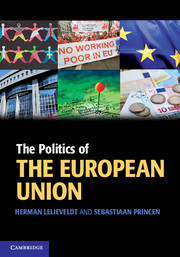Book contents
- Frontmatter
- Contents
- Acknowledgements
- List of briefings
- List of fact files
- List of controversies
- List of tables
- List of figures
- List of abbreviations and acronyms
- List of country abbreviations used in tables and figures
- Preface
- PART I Setting the scene: origins, analytical perspectives and institutions
- PART II Key actors in EU politics: citizens, interest groups and political parties
- 5 Public opinion and political participation
- 6 Interest groups and interest representation
- 7 Political parties and the European Parliament
- Part III EU policies: agenda-setting, decision-making and implementation
- Conclusions and reflections
- Key terms and concepts
- Index
7 - Political parties and the European Parliament
from PART II - Key actors in EU politics: citizens, interest groups and political parties
- Frontmatter
- Contents
- Acknowledgements
- List of briefings
- List of fact files
- List of controversies
- List of tables
- List of figures
- List of abbreviations and acronyms
- List of country abbreviations used in tables and figures
- Preface
- PART I Setting the scene: origins, analytical perspectives and institutions
- PART II Key actors in EU politics: citizens, interest groups and political parties
- 5 Public opinion and political participation
- 6 Interest groups and interest representation
- 7 Political parties and the European Parliament
- Part III EU policies: agenda-setting, decision-making and implementation
- Conclusions and reflections
- Key terms and concepts
- Index
Summary
Introduction
In March 2009 David Cameron, the leader of the British Conservative Party, announced that the Conservatives would form a new political group in the European Parliament after the EP elections of June that year. In doing so, the Conservatives would break away from the Christian Democrat European People's Party (EPP), with which it had been allied in the EP for almost two decades.
The relationship between the Conservatives and the EPP had always been strained, as the Conservatives were much more Eurosceptical than the (traditionally strongly pro-EU) ‘continental’ conservative and Christian democratic parties assembled in the EPP. Before joining the EPP group, the Conservatives had cooperated with like-minded parties in the ‘European Democrats’ (ED) group. When the British Conservatives decided to join the EPP political group in 1992, they only did so as an ‘associated party’. In 1999, this associated status was made more visible by adding ‘ED’ to the name of the EPP group in Parliament. Still, the British Conservatives continued to disagree with the EPP ‘party line’ on many important issues and frequently threatened to withdraw from the EPP-ED group altogether to form their own political group.
Cameron's decision to set up a new political group attracted a lot of criticism within his own party. Several Conservative Members of the European Parliament (MEPs) voiced their discontent with the move, fearing that the Conservatives would lose influence in the EP.
- Type
- Chapter
- Information
- The Politics of the European Union , pp. 151 - 176Publisher: Cambridge University PressPrint publication year: 2011



